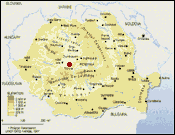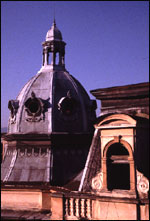|
|
Romania
is located in southeastern Europe and is about the size
of Oregon. Its neighbors are Hungary, Ukraine, Moldova,
Bulgaria and Serbia and the Black Sea. Today's 24 million
Romanians are descendents of native Dacians and 2nd Century
BC Roman invaders, while the language they speak is considered
the purest living form of Latin. There are large numbers
of Bulgarians, Hungarians and Germans in pockets around
the country. Many words from those languages add spice to
modern Romania. You will also hear many words from Russian
and Turkish. Centuries of political domination of the Romanians
by those two erstwhile powerful neighbors left indelible
marks on the culture.
Bucuresti
(Bucharest) is the capital of Romania. It was once called
the Paris of the Balkans thanks to its wide, tree-lined
boulevards and imposing memorials. Around two million people
live in the capital on the country's fertile southern plain.
Other major cities include Iasi, Cluj, Sibiu, Timisoara
and Brasov.
The
Danube and the Carpathians give character and heart to Romania.
The Danube forms much of the southern border of Romania
with Bulgaria, separating Latin from Slav. The great river
divides into three forks and becomes a broad, marshy delta
before it merges into the Black Sea. The southern plain
of Romania is a breadbasket of grains and fruits, a potential
source of food for all of Europe.
Farther north, the craggy Carpathian Mountains, the eastern
end of the Alps, rise up to split the country virtually
in half. Two passes traverse the wild mountains creating
two different perspectives, one markedly eastern and the
other, the Transylvania culture north of the mountains,
looking toward the west.
South
and east of the Carpathians the land was defenseless to
frequent invasion by Turk, Tatar, Magyar and Russian. North
of the Carpathians massive fortresses and walled cities
were built by German settlers, invited to protect the passes
and keep the invaders at bay. Sibiu, Brasov, Sighisoara
and other cities carry both Romanian and German names in
recognition of their mixed heritage. Other cities add a
third name, usually Hungarian. It has been against Hungarian
rule from Budapest and Turkish suzerainty from Istanbul
that Romanians have most often fought. In the last two hundred
years Russian imperialism has been an increasing threat
to Romania, culminating in 45-years of Soviet domination.
Vurpar
is fifteen miles from Sibiu (Herrmannstadt), a city of 200,000
persons. Sibiu was built by Romanians and Saxons to protect
the strategic nearby pass from invasion. Surrounded by mountains,
decorated with great churches, medieval walls, grand plazas
and charming cafes, Sibiu is an undiscovered tourist attraction
with rock bottom prices and lovely attractions. It is where
the children of Vurpar go on to high school and where occasional
bus loads of Sasi return to visit friends, relive events
and snap a few shots for family back "home" in
Germany.
It
was in this town square that citizens fought heavily armed
communist forces during the 1989 Revolution. The people
won and now have a budding democracy. In the center of the
square is a memorial to the men and women who died in Sibiu
fighting the dictatorship.
|






